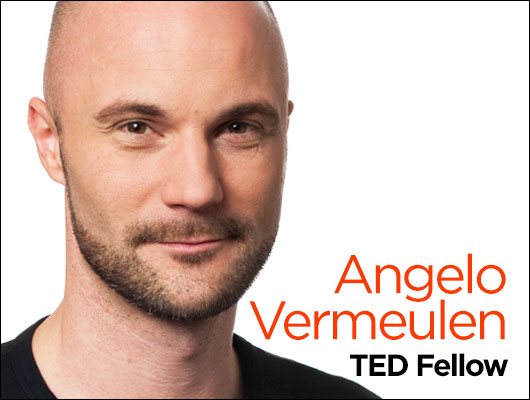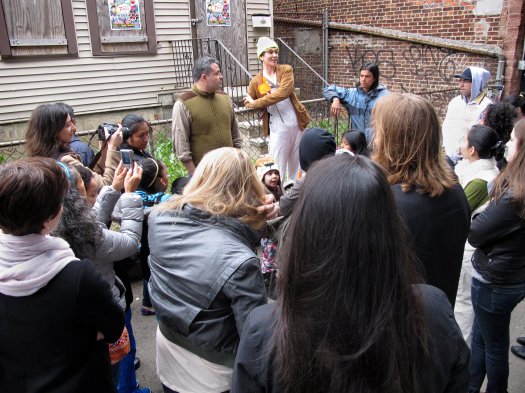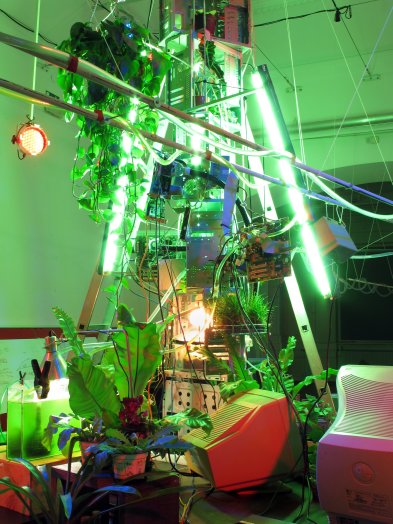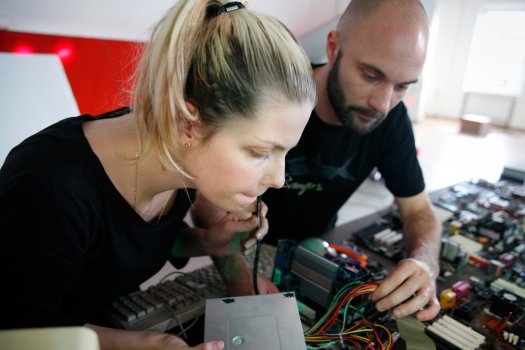
Do you consider yourself an artist or scientist first?
I usually describe myself as an artist with a background in science, but I feel first and foremost an artist. Artist, biologist, space researcher, and TED Fellow — that’s how I describe myself now, but it changes.
It seems when people are confronted with a hybrid practice, they want to figure why. It’s not an easy question to answer. One thing crucial to everything I do is exploration. But then one might wonder, “Why don’t you just become and stay a scientist?” One thing that struck me when I was a scientist is the incredible degree of specialization needed to develop within the discipline. This is generally a good thing. But it started stifling my creativity. I felt I wasn’t using my full potential.
So I started studying photography while I was doing my PhD research in ecology. In the evenings I would be in the darkroom; in the daytime I did scientific research. During the course of that parallel practice, which lasted for quite a few years, I discovered an enormous sense of freedom that I felt was missing in my science practice. I got absorbed by arts, all arts — much more than just photography. One exhibition that really hit me in the face was the contemporary arts exhibit Documenta X, in Germany. There was a lot of documentary work, a lot of video and photography, not National Geographic style, but more radical experimental stuff. For me, this was a huge eye-opener. This was also a form of exploration: making documentary photography, using documentary video. At the same time, it involved strong artistic expression. And it didn’t have to fit into a specific, narrow framework.
After finishing my PhD I decided to dedicate myself full-time to the arts. Then, within the arts I began to incorporate biology — which finally led me to work with biological, technological, as well as social systems. Bear in mind this was all part of one organic process that is still developing.
Is this where Biomodd, your longest-running project, comes in?
Yes. I started Biomodd in 2007. The core idea of the project is to intricately interconnect a biological living system with a recycled computer system. The main reason to do this is, first of all, to show people a different relationship between computer electronics and biology. Not one of opposition – because many people think of computers in opposition to nature – but of making them work together. On the other hand, the work is very much inspired by popular culture and science-fiction themes in which living biological cells merge with electronic components.
Biomodd brings this idea into physicality as an artwork. It’s an ongoing series of computer networks assembled out of recycled components in which a living ecosystem is installed. The ecosystem uses the waste heat of the electronics to grow and develop. This was the basic, core idea. So Biomodd incorporates energy recycling, computer recycling and ecological growth. There is also a social dynamic involved: I’m not building the projects in my studio and then shipping them to a museum for exhibition. I’m going to a location, putting the idea on the table, and inviting people to work with me to find its shape. Depending on the culture we’re working in — because I’ve been doing this in many different places around the world — each Biomodd project takes its own particular shape. Sometimes, people from former Biomodd versions come over and join the new team, so you get these interesting exchanges of experience and ideas around the project.
Biomodd usually gets disassembled afterwards, and the units that have been built by the participants usually get adopted, with some pieces getting incorporated into subsequent Biomodds. So Biomodd is essentially an ongoing iteration of an idea. It’s also an open-source project, so those who want to can build and own their own versions. Biomodd just pops up in different places.
In the beginning, there was a strong focus on just energy recycling. Now the concept is much more about how to make both the living biological system and the electronic system communicate. At first, the communication only went one way: heat exchange from the computer system to the biological system. But now we’re also working on robotics. We’re also working with sensors. We’re exploring multiple ways in which both systems can really come together and start exchanging different things like data, behavior and energy.
How do the plants communicate with the computer? I can see how the computer gives heat to the plants and helps them grow, but is there any feedback from the plants to the computer?
We’re currently working on that. We’re developing a large and complex version of Biomodd in New York City for an exhibition called ReGeneration at the New York Hall of Science. It’s NYSCI’s first contemporary art exhibit, so it’s quite exciting to be part of that. This new Biomodd explores the concept of mixed reality, which means that you have your ecosystem and your virtual world constantly acting on each other. The ecosystem, through sensors and data streams, is continuously adjusting the virtual world in real time. Imagine walking in a computer game, and the game environment is constantly morphing, driven by changes in the ecosystem — a beautiful connection between the real and the virtual. Mixed reality kicks in as soon as you allow the game and its players to change the ecosystem as well. So you allow the game, for example, to manipulate the ecosystem using robotics and artificial intelligence. You can build a whole battery of robotics that add nutrients, add water, change lighting, cut down plants, and so on. And so the game itself is also having a potential impact on the ecosystem. Both the ecosystem and the virtual world can continuously bounce off each other. When it becomes impossible to disentangle cause and effect, you create a new, mixed reality. This is something we’re working on in New York City in collaboration with Parsons The New School for Design. So this is, obviously, a huge challenge and a pretty complex thing.
What do Biomodd ecosystems usually consist of?
Usually they consist of plants, single-celled algae and fish. But I’m always open to broadening the concept. For the New York version, we have changed things a little bit. We’re shifting entirely to urban agriculture, and the plants won’t be grown in a single structure, but will be distributed throughout the museum building. There will be different components: a huge window farm at the entrance of the museum will be taken care of by the robotics I was just talking about. The robotics will controlled by a central plant-computer unit positioned in the central exhibition space of the museum, which is actually former bomb shelter architecture from the ’60s. And so it becomes this kind of sci-fi-referencing structure built around the idea of “survival.” Every single plant that will be grown in Biomodd will be edible. It’s food being generated by the artwork throughout the exhibit. We’ll be organizing food events, harvesting and sharing what we grow.
Why did you make that shift?
First of all because of the location of the exhibit. The museum was built as part of the World’s Fair in Flushing Meadows-Corona Park in 1964. It was designed by Harrison and Abramovitz. The bomb shelter architecture that I talked about before was a demonstration of how the US could protect itself against nuclear fallout. It’s a completely concrete insulated environment; there’s no daylight. And I was invited to build Biomodd there. At first, I thought, “How will I develop Biomodd in a room without any daylight? This doesn’t make any sense.” However, when I heard that it’s actually fallout shelter architecture, it became very interesting! Suddenly Biomodd was about survival. We saw the opportunity to turn it into an experimental food production system where people can see how to grow food in difficult urban circumstances. And this is, of course, a huge challenge for the entire urbanized part of the world.
Secondly, the NYC Biomodd team decided that they wanted to actively reach out to the people living around the museum. These people are mostly immigrants, the majority from places other than Corona in Queens — mostly from Latin America, but also from Asia. We decided this would be an interesting way to connect with the local community, to invite people to grow foods and plants from their original region and incorporate that in Biomodd. Part of the Biomodd team has already started doing urban gardening experiments with the local community in collaboration with an arts organization called Immigrant Movement International, which is near the museum. You can already see a little experimental garden being grown there. The preparatory project even has its own name: Springmavera. The idea is to explore experimental urban gardening and slowly introduce elements of technology — basic sensors, maybe some simple robotics — and gradually grow towards the idea of Biomodd. In September, we’ll move the entire experiment through a parade through the streets of Corona up to the museum together with the local community. So that will be quite interesting.
So how did you go from projects like Biomodd to working on the possibilities for future space habitats?
My artwork attracted the attention of the European Space Agency — in particular a very specific research program called MELiSSA, short for Micro-Ecological Life Support System Alternative. MELiSSA is actually an ecosystem under development that should allow future space settlement. Based on the concept of an artificial ecosystem, it is the European model for a regenerative life support system for astronauts. It allows the production of oxygen, water and food, and the recycling of organic wastes and carbon dioxide. Such regenerative life support systems will enable future long-term manned space missions such as a lunar base or a mission to Mars by ensuring crew survival. The system is already test running in Barcelona, but it’s still too big to be launched. My art — hybrid, semi-enclosed systems of biology and technology — is almost like an illustration of some of these ideas.
The people working on this program found my work interesting and invited me to think with them about the future of their system: how could MELiSSA evolve into a true human habitat — not a laboratory, but a habitat with human qualities? This is a fantastic invitation, of course. But the problem is actually so complex and challenging that I decided to turn it into a second PhD. So right now, I’m enrolled as a PhD student at Delft University of Technology, researching the idea of future habitation in space with embedded ecosystems. So, not just rockets or traditional space stations, but really bringing biology in there. I’m approaching it not just from a design point of view but also from an artistic and ethical point of view. This is the unique approach that I created for my PhD — exploring the future of human habitation and survival using design, engineering, modeling, art and ethics. This brings me to the social aspect of my research. What kind of rules do you use in a system like this? What values do you embrace when you want to build a habitat that includes technological systems, biological systems and people?
What does your research focus on?
It basically embraces two things that, for some people in the space industry, are still considered taboo. Number one: introducing biological living systems to survive. For some space engineers, this is still very difficult to accept, because for them biology is a very unstable and unpredictable system, and they don’t want to rely on it. Number two: introducing participatory systems. I’m part of the research group at Delft called Participatory Systems Initiative, headed by Professor Frances Brazier. The goal of the initiative is to figure out how we can redefine cohabitation — working together, producing together, creating together from a networked point of view and not from a top-down point of view.
Currently there’s a military-style collaboration in space missions: ground control basically controls every single minute of the astronaut’s experience. Astronauts are operators. However, it would be interesting to rethink this tradition and create a system where astronauts have to figure things out on their own, and have to work together in a more horizontal structure. Consider energy production: traditionally this is a very top-down system. You have no idea what happens between production and consumption, and you have no say in any of this. In a participatory energy system, every house using solar and wind energy would be its own energy producer. The surplus energy would be fed back to the grid to be used where it’s needed.
I actually think this is the future of humanity: we would be much better off if we were to organize ourselves more in such systems. Within the context of space exploration, after a certain point, ground control can no longer control every minute of space inhabitants’ lives, for example, if people were residing on Mars. Participatory system design will then be inevitable. It’s also important to build a very resilient system. And that’s what I’m focusing on: building resilient systems from a social, technological and biological point of view — systems that can reconfigure and optimize themselves according to their needs.
How are you getting advisors in this program? What you’re doing is so new — are you designing your own course?
That’s a good question. I learn about participatory systems, and by extension social systems, from my advisors in Delft: Professor Frances Brazier and Dr Caroline Nevejan. For the design and technology side of it, I’m actually still looking for people to work with. I’m currently a Michael Kalil Endowment for Smart Design Fellow at Parsons in New York City. This is a wonderful opportunity because Michael Kalil was a space designer himself. He actually worked on space habitation from a very holistic point of view. So it just came to me at a perfect moment. And I’m also having many conversations about my PhD research with the urbanist Bill Morrish. He has very similar ideas about these networks and participatory structures. So I can learn a lot from him, too.
How has the TED Fellowship changed your way of thinking and working?
Well first of all, the effect of being introduced to fellow Fellows is really — there’s no way around it — very inspiring. Just to see everybody’s path, and even the nuts and bolts of just trying to make your dream come true — you learn a lot from that. And we’re all very open. That’s the nice thing about the TED Fellows community. People don’t have too many secrets; we ask something and we get something. I’m based in Belgium, so I’m not really constantly in contact with them, but when I’m in New York I try and meet up with the Fellows at the Metropolitan Exchange in Brooklyn. It’s one of those hotspots of creativity in New York right now. TED Fellows James Patten and Joachim Mitchell work there, for example. Another aspect that is really interesting is that I can ask specific questions of the TED Fellows coordinators. Sometimes it’s just practical advice, like, “Listen, I want to get a book translated and I want to publish it. How would I do that?” That’s the advantage of being able to tap into the network of TED.
But the thing that has made a really huge impact is the coaching I got through SupporTED. It’s a combination of life and career coaching. The interesting thing is that my coach Jay Perry manages to give me very simple advice — no complicated plans or strategies, just simple things that turn out to be quite powerful. Just to give you an example: one of the first pieces of advice I got from my coach was, “Try to not turn on your computer before noon and see what happens.” I felt that I spent too much time behind the computer and not enough time nurturing myself, or just simply creating stuff. And indeed, Jay’s suggestion was quite a revelation. I just sat down and started drawing and reading and all the old-school stuff. I try to do it still, but I don’t always manage. But it’s continuously in the back of my mind.
![AV_090908_012_croppedx Biomodd [LBA2]](http://wpvip.ted.com/wp-content/uploads/sites/2/2012/05/av_090908_012_croppedx1.jpg?w=393)



Comments (4)
Pingback: Spatzle in space: Fellows Friday with Angelo Vermeulen | Krantenkoppen Tech
Pingback: HI-SEAS – TED Fellow and HI-SEAS crew commander Angelo Vermeulen
Pingback: Event Blog: Biomodd Lecture and Workshop | Fu, Angie